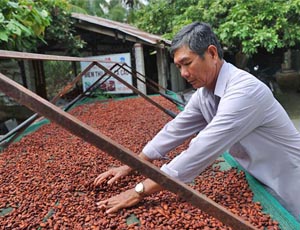Vietnam’s Cocoa Growers Look for Sweet Deal in the Chocolate Industry
 HANOI – Cocoa growers and chocolate manufacturers are increasingly viewing Vietnam, with its warm and humid climate, as an ideal growing location for cocoa beans – the key ingredient in chocolate. Moreover, as the demand for chocolate grows, Vietnam is well positioned to become one of the world’s newest suppliers of high quality cocoa beans.
HANOI – Cocoa growers and chocolate manufacturers are increasingly viewing Vietnam, with its warm and humid climate, as an ideal growing location for cocoa beans – the key ingredient in chocolate. Moreover, as the demand for chocolate grows, Vietnam is well positioned to become one of the world’s newest suppliers of high quality cocoa beans.
Currently, in Vietnam there are more than 54,000 acres devoted to the growing of cocoa beans — though this pales in comparison to the vast acreage, 10.3 million acres, used for growing rice.
 RELATED: Dezan Shira & Associates’ Global Services
RELATED: Dezan Shira & Associates’ Global Services
According to TJ Ryan, managing director of the non-profit organization ACDI-VOCA, “Cocoa produces roughly three years after planting and, in Vietnam, is promoted as a complement to existing crops. Once the cocoa begins producing, the average farmer harvests more than half a ton of cocoa, which provides approximately US$1,000 in additional income for the family.” He also added that there are plans to improve Vietnam’s production by 50 percent by next year.
Ten years ago, there was little cocoa production in Vietnam. At that time, one of the few cocoa producers in the country was a public-private partnership led by ACDI-VOCA, along with partners like chocolate manufacturer Mars.
RELATED: Coffee Prices Soar as Coffee Bean Sales Slow in Vietnam
Today, there are an increasing number of new entrepreneurs looking to take advantage of Vietnam’s fertile growing lands. A prime example of the new businesses that have arisen is Marou, a confectionary chocolate firm founded three years ago by two French entrepreneurs in the southern region of Vietnam. The owners of Marou, Samuel Maruta and Vincent Mourou, have described the Vietnamese cocoa beans as “very fruity and bold, and lot of character, power with finesse.”
Chocolate is not new to Vietnam – French colonists planted cocao beans during the 1800s. However, over time the beans were outpaced by more profitable crops such as coffee, cashews, and pepper. Additionally, in the late 1980s, Russian growers attempted to plant cocoa trees but they fled the country and abandoned the crops after the collapse of the Soviet Union.
Asia’s sweet tooth
While demand for chocolate in Asia has been somewhat low, this trend appears to be changing. In recent years the market for chocolate in Asia generated revenues of US$12 billion. Further showing this increase in demand, last December, the International Cocoa Organization predicted that there could be a shortage of 150,000 tons in the amount of cocoa beans produced in 2014. In possible reaction to this perceived future shortage, in March of this year cocoa prices reached a two and a half year high of around US$3,000 per ton in London and New York.
While China represents a significant portion of this growth in consumption, countries like Indonesia will also see significant growth over the coming years. Indonesia is currently the world’s third largest producer of cocoa and its domestic consumption of chocolate is set to grow twofold over the next three years, as a result of more people joining the middle class. However, the country’s domestic production is showing signs of not being able to keep up with demand – in April estimations were that domestic grinders would face a shortfall of 100,000 metric tons of cocoa beans due to a failure to increase crop yields enough.
According to Euromonitor International Ltd., by 2018, the Asia Pacific region will consume 1.096 million tons of chocolate, a 27 percent increase from 2013. This will be a significant opportunity for established cocoa bean producers such as Ghana, Ivory Coast and Indonesia, as well as for emerging producers like Brazil, Ecuador, South Africa and Vietnam.
Asia Briefing Ltd. is a subsidiary of Dezan Shira & Associates. Dezan Shira is a specialist foreign direct investment practice, providing corporate establishment, business advisory, tax advisory and compliance, accounting, payroll, due diligence and financial review services to multinationals investing in China, Hong Kong, India, Vietnam, Singapore and the rest of ASEAN. For further information, please email vietnam@dezshira.com or visit www.dezshira.com.
Stay up to date with the latest business and investment trends in Asia by subscribing to our complimentary update service featuring news, commentary and regulatory insight.
Related Reading
 An Introduction to Doing Business in Vietnam 2014 (Second Edition)
An Introduction to Doing Business in Vietnam 2014 (Second Edition)
An Introduction to Doing Business in Vietnam 2014 (Second Edition) provides readers with an overview of the fundamentals of investing and conducting business in Vietnam. Compiled by Dezan Shira & Associates, a specialist foreign direct investment practice, this guide explains the basics of company establishment, annual compliance, taxation, human resources, payroll, and social insurance in the country.
Foreign Investment Needed for Infrastructure and Agriculture Projects in Vietnam
Vietnam TPP Update: Edging Closer to Completion
Regional Spotlight: Vietnam’s Mekong River Delta
- Previous Article Vietnam Government Cracks Down on Protesters, Pledges to Protect Foreign Investors
- Next Article Developing Your Sourcing Strategy for Vietnam: New Issue of Vietnam Briefing Magazine

































